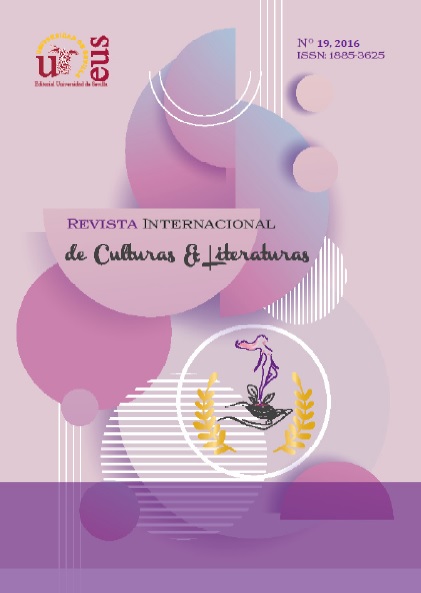DANCING TO CREATE ALTERNATIVE AND HEALING SPACES IN MIRA NAIR FILMS
DOI:
https://doi.org/10.12795/RICL.2016.i19.25Palabras clave:
Mira Nair, dance, South Asian Subcontinent, filmResumen
Este artículo estudia cómo Nair representa personajes femeninos que se empoderan utilizando elementos de danza de la tradición de las artes escénicas del sur de Asia para subvertir las formas históricas de dominación colonial (y neocolonial) del Imperio Británico basadas en la raza y el género.
Abstract
This paper studies how Nair represents female characters that empower themselves using dance elements from the South Asia Subcontinent performing arts tradition to subvert the British Empire historical forms of colonial (and neo-colonial) domination based on race and gender.
Descargas
Citas
Balaswarati, T. (Bala), “Bala on Bharata Natyam” Sruti 5 (1984): 11-15.
Barba, E., La canoa de papel: tratado de antropología teatral. Madrid Catálogos, 1999 (1993).
Bharata M., Natyasastra (English translation with critical notes by AdyaRangacharya). New Delhi: Munshiram Manoharlal Publishers Pvt. Ltd., 2010. Print.
Biwi No.1 Dir. David Dhawan. TTV and Natwest, 1999. Chatterjea, A., Personal Interview. Barcelona, 1 Oct. 2011a.
Daly, A., “Unlimited Partnership: Dance and Feminist Analysis.” Dance Research Journal, 23 1 (1991): 2-5.
Diego Sánchez, J., “Hybrid Cinemas and Narratives: Gender Representations inWomen’s Cinema of the South Asian Diaspora”. Universidad de Salamanca, 2015.
<http://gredos.usal.es/jspui/handle/10366/128136> Web. 8 Jan. 2016.
Dinesh, M. R. and Ramanathan, L., Bharatanatyam, Yesterday, Today, Tomorrow. New Delhi: Sujata Dinesh, 1985.
Fux, M., Qué es danzaterapia. Preguntas que tienen respuesta. Madrid: LumenHumanitas, 2005.
Gibbons, R., “Traditional Enactments of Trinidad: Towards a Third Theatre.” M. Phil. Thesis, University of the West Indies, 1979.
Gilbert, H., “The Dance as Text in Contemporary Australia Drama: Movement and Resistance Politics.” ARIEL 23 (1992): 133-48.
Gilbert, H, and Tompkins, J., Post-Colonial Drama. Theory, Practice, Politics. London and New York: Routledge, 1996.
Giroux, H. A., “When Hope is Subversive.” TIKKUN 19 6 (2004): 38-39.
González Cruz, I., Natyasastra. Tratado fundamental de Poética, Composición yArtes Escénicas. Valencia: Letra Capital, 2013.
Maillard, C. and Pujol, Ó., Rasa. El placer estético en la tradición india.Madrid: Etnos: 1999.
Massey, R., India’s Kathak Dance Past, Present Future. New Delhi: Shakti Malik, Abhinav Publications, 2014 (1999).
Mississippi Masala. Dir. Mira Nair. Mirabai Films, 1991. DVD, 2008.
Morcom, A., Illicit Worlds of Indian Dance. Cultures of Exclusion. Oxford: Oxford University Press, 2014.
Moya, A., “The Politics of Re-presenting Vanity Fair: Mira Nair’s Becky Sharp.” ATLANTIS. Journal of the Spanish Association of Anglo-American Studies. 32 2 (December 2010): 73-87.
Monsoon Wedding. Dir. Mira Nair. IFC prdocutions, Mirabai Films, Keyfilms Roma, Pandora Filmproduktion, Paradis Films, Baron Pictures (II), Delhi Dot Com, 2001. DVD. 2007.
Nair, M., “Kama Sutra: an interview with Mira Nair.” Online Daily the University of Washington. 13 Mar. 1997.
<http://dailyuw.com/archive/1997/03/13/imported/kamasutra-interview-mira-nair>. Web. 24 Feb. 2005.
Nuir, J. K., Mercy in Her Eyes. The Films of Mira Nair. New York: Applause Theatre & Cinema Books, 2006.
O’Shea, J., At Home in the World: Bharata Natyam on the Global Stage. Connecticut: Wesleyan, 2007.
Porter Phinzy, C., “Subtle Subversion in Indian Cinema: Mira Nair’s Use ofBritish Orientalism in Vanity Fair.” Modern Art Asia. 12 (November 2012): 1-16.<https://www.academia.edu/2398594/_Subtle_Subversion_in_Indian_Cinema_Mira_Nairs_Useof_British_Orientalism_in_Vanity_Fair>_ Web. 12 Jun. 2016
Rangacharya, A., Natyasastra. English Translation with Critical Notes. New Delhi: Munshiram Manoharlal Publisheres Pvt. Ltd., 2010.
Roychowdhury Dasgupta, S., Personal Interview. Madrid, June 2014.
Sarabhai, Mrinalini. The Sacred Dance of India. Bombay: Bharatiya Vidya Bhaven, 1979.
Savarese, N., “The Experience of the Difference: Eurasian theatre, an Ancient Tradition of Performance and Theory.” The Dramatic Touch of Difference: Theatre, Own and Foreign. Eds. Josephine Riley Fischer-Lichte and Michael Gissenwehrer. Tübingen: Gunter Narr Verlag Tübingen, 1990. 43-48.
Sklar, D. S., “Dance Ethnography” in Dance Research Journal 23 1 (1991): 6-10.
Tagore, R., Natir Puja (The Court Dancer) in Two Buddhist Plays. Kolkata: Writer’s Workshop, 1993b (1932). 7-61.
The Namesake. Dir. Mira Nair. Dir. Mira Nair. Fox Searchlight Pictures, Cine Mosaic, Entertainment Farm (EF), Cinem Mosaic, Mirabai Films, UTV Motion Pictures, 2006. DVD. 2007.
Vanity Fair. Dir. Mira Nair. Focus Features, Franada Film Production, Epsilon Motion Pictures, Tempesta Films, 2004. DVD. 2005.
Vatsyayan, K., The Square and the Circle of the Indian Arts. New Delhi: Roli Books International, 1983.
Winton-Henry, C., Dance--The Sacred Art: The Joy of Movement as Spiritual Practice. Woodstock (VT): SkyLight Paths Publishing, 2009.

